
Printed photos are beautiful to the eye and an excellent way for photographers to share their work. However, knowing the approach to take when translating your picture to paper can be challenging, especially if you are a starter. Two of the most common finishes for photo paper are glossy and matte, and each style is suitable for different situations.
It is essential to know that glossy and matte inkjet papers are both coated for photo or art quality reproduction. If you are having trouble deciding how to print your pictures on matte vs glossy finish paper, we will help you decide by comparing them below.
What is Matte Paper?
By definition, matte papers have a non-reflective surface, and matte papers can be smooth or have a texture. Matte photo paper is coated, so inkjet inks will adhere to the surface and produce bright colors and sharp detail.
When to Use Matte Photo Finishes
Matte photo finishes are best when you want to reduce the reflections and glare from a print. This type of finish is ideal if you plan to display your photo behind glass. Images with a matte finish can be shown even in bright areas and can be viewed from just about any angle without glare. Because of the low reflective quality, matte prints are great when you want the viewer to see every detail in the image. They are a good choice when you want a more subtle effect or subdued feel. A bonus is that in many cases, matte papers cost less than glossy paper.
Disadvantages of a Matte Photo Finish
The main disadvantage of matte paper is that, compared to glossy, it has less pop and saturation, and this is because they refract light instead of reflecting it back to your eyes. If you are looking for maximum color saturation and print performance, you should consider glossy instead of matte paper.
What is Glossy Paper?
Glossy paper is usually smooth and has a highly reflective surface. Glossy photo papers are coated, so inkjet inks will adhere to the surface and produce bright colors and sharp detail. Because of the reflective surface, colors are more vibrant and saturated.
When to Use a Glossy Finish
Choose glossy paper when you need your photo prints to be as bold and bright as possible. Glossy paper can work for just about any photo subject from vacation snaps to portraits to scrapbook pages.
Disadvantages of Using a Glossy Photo Finish
Glossy paper can be problematic because of the reflection and glare. Large prints under bright light can be challenging for viewers; they may have to reposition themselves several times to see all of the image. If you put glossy paper behind glass, it is recommended to use anti-glare glass.
Glossy vs Matte Photo - Which is Best?
When it comes to choosing between glossy or matte photos or finishes, the decision often boils down to personal preference and the desired aesthetic for your prints. Glossy photos feature a shiny, reflective surface that enhances color saturation and contrast, making them ideal for vibrant images with bold colors and fine details.
On the other hand, matte photos have a non-reflective surface that minimizes glare and fingerprints, imparting a softer, more subdued look to your prints. Matte finishes are often preferred for black-and-white photos, portraits, and images with a classic or understated style. Ultimately, whether you opt for glossy or matte photos depends on the mood, tone, and visual impact you wish to achieve with your prints.
Conclusion
Using glossy or matte paper for your printed photo depends entirely on your needs. For example, if you want a vibrant photo with high contrast and saturated color, it would be best to print it on glossy paper. However, if you want something more subtle or want to avoid glare, it would be best to use matte paper for printing.
Last updated: April 29, 2024




